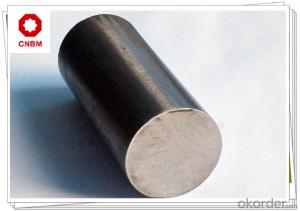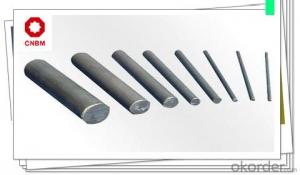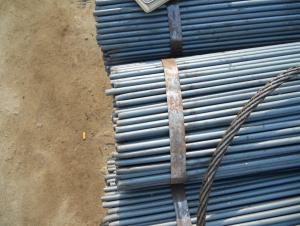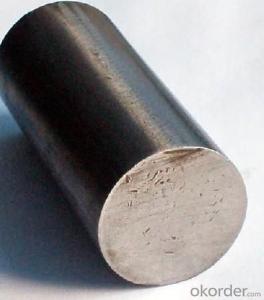Carbon Structural Steel Round Bars SS400CR
- Loading Port:
- Shanghai
- Payment Terms:
- TT OR LC
- Min Order Qty:
- 25 m.t.
- Supply Capability:
- 120000 m.t./month
OKorder Service Pledge
OKorder Financial Service
You Might Also Like
Carbon Structural Steel Round Bars SS400CR
PRODUCT SPECIFICATION
1, p ≤0.050%; S ≤0.050%; Cr ≥0.30%
2, Strength of Extension σb ≥400 Mpa
Yield Strength σs ≥245(25) Mpa
APPLICATION
1, Widely be used in construction and engineering structure.
2, Widely be used in making reinforcing steel bar or building plant room rack, high voltage transmission tower, bridge, vehicle, boiler, vessel, ship, etc.
3, Widely be used in manufacturing mechanical parts which do not require high performance.
4, SS400CR with grade C or D can be used as steel with special use.
PRODUCT MAIN POINTS
1, Heat Treatment: normalizing, annealing, tempering, quenching
2, Surface Treatment: black, bright, polished, galvanized
3, Product Process: hot rolled, cold drawn, forged
FAQ
1, Payment Terms:
30% T/T deposit & 70% T/T before delivery.
Irrevocable L/C at sight
2, Trade Terms:
FOB, CIF, CNF
3, Delivery Time:
Normally 30-40 days. According to quantity.
4, Manufacture or Trading Company:
CNBM is a state-owned fortune global 500 trading company. We have intergrated supply system.
There are about 20 overseas locations in different countries.
PRODUCT SHOW
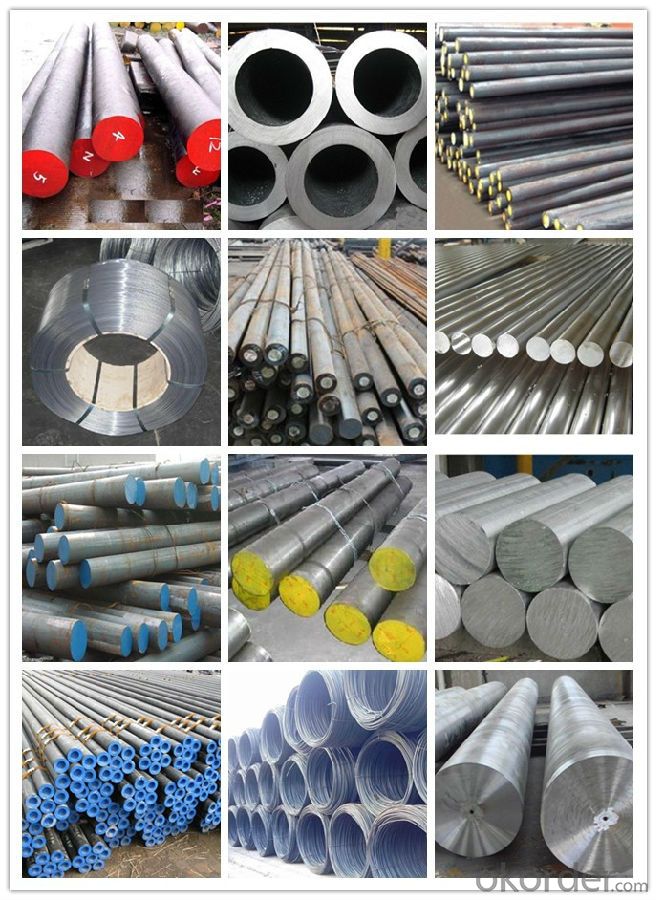
ABOUT US


- Q:Are steel round bars suitable for the production of valves?
- Indeed, valves can be produced using steel round bars. Steel is a widely employed material in valve manufacturing owing to its exceptional mechanical characteristics, including remarkable strength, durability, and resistance to corrosion. By machining and shaping steel round bars, one can effortlessly create diverse valve components that provide the essential strength and stability to endure high pressure and temperature conditions. Moreover, through heat treatment, the mechanical properties of steel round bars can be enhanced, thus further boosting the performance and reliability of valves. In summary, steel round bars are an appropriate option for valve production as they guarantee functionality and longevity in a multitude of industries and applications.
- Q:What is the difference between a seamless and a precision ground steel round bar?
- A solid cylindrical steel billet is heated and pierced to create a hollow tube-like structure, resulting in a seamless steel round bar. This manufacturing method guarantees a uniform outer diameter throughout the entire length of the bar, making it ideal for applications that necessitate a smooth surface finish and high dimensional accuracy. Industries such as oil and gas, automotive, and aerospace commonly employ seamless round bars. On the contrary, a precision ground steel round bar is produced by subjecting a hot-rolled or cold-drawn steel bar to precise grinding processes. These processes eliminate any surface imperfections, achieve meticulous dimensional tolerances, and provide a polished and smooth finish. Precision ground round bars are typically utilized in applications that require strict tolerances, superior surface finish, and consistent dimensions, such as in the production of machinery parts, tools, and components. In conclusion, the primary distinction between a seamless and a precision ground steel round bar lies in the manufacturing process and the resulting characteristics. Seamless round bars are formed from a hollow tube-like structure, ensuring a consistent outer diameter, whereas precision ground round bars are created by grinding a solid steel bar to achieve tight tolerances and exceptional surface finish. Both types of round bars offer their own advantages and find application in various industries based on specific requirements.
- Q:What are the different bending methods for steel round bars?
- There are several different bending methods that can be used for steel round bars, depending on the desired outcome and the specific application. Some of the most common bending methods for steel round bars include: 1. Cold Bending: This method involves bending the steel round bars at room temperature without the use of heat. Cold bending is typically performed using specialized bending machines or tools that apply force to the bar to achieve the desired shape. 2. Heat Bending: Heat bending involves heating the steel round bar to a specific temperature to make it more malleable and easier to bend. Once heated, the bar is bent using specialized tools or fixtures. Heat bending is often used for more intricate or precise bends that cannot be achieved through cold bending alone. 3. Induction Bending: Induction bending is a process that uses an induction coil to heat the steel round bar locally, allowing it to be bent gradually and smoothly. This method is commonly used for large diameter or thick-walled round bars, as it provides greater control over the bending process and minimizes distortion or damage to the material. 4. Roll Bending: Roll bending involves passing the steel round bar between a set of rollers that gradually bend it into the desired shape. This method is often used for larger diameter or longer round bars, as the rollers provide continuous support and ensure consistent bending across the entire length of the bar. 5. Mandrel Bending: Mandrel bending is a technique that uses a mandrel, or a rod inserted inside the steel round bar, to support the inner walls during the bending process. By using a mandrel, the bar maintains its shape and prevents the formation of wrinkles or deformations on the inside of the bend. Each bending method has its own advantages and limitations, and the choice of method will depend on factors such as the size and thickness of the round bar, the required bend radius, and the desired quality of the final product. It is important to consult with experts or professionals in the field to determine the most suitable bending method for a specific steel round bar application.
- Q:What are the different grades of tool steel round bars?
- Tool steel round bars are available in various grades, each offering unique properties and characteristics to suit specific applications. Some of the different grades of tool steel round bars include: 1. W1: This is a water-hardening tool steel with relatively low carbon content. It is known for its excellent toughness and good wear resistance. W1 tool steel round bars are commonly used for cutting tools and woodworking tools. 2. O1: O1 tool steel round bars are oil-hardening tool steel with high carbon content. They have good wear resistance, high toughness, and excellent dimensional stability. O1 tool steel is often used for punches, dies, and cutting tools. 3. A2: A2 tool steel round bars are air-hardening tool steel with medium carbon and chromium content. They offer good wear resistance, excellent toughness, and high dimensional stability. A2 tool steel is commonly used for blanking and forming dies, as well as shear blades. 4. D2: D2 tool steel round bars are high-carbon, high-chromium tool steel with excellent wear resistance and good toughness. They offer high resistance to abrasive wear and are often used for making cutting tools, punches, and forming dies. 5. M2: M2 tool steel round bars are high-speed steel with a significant amount of tungsten, molybdenum, and vanadium. They have exceptional wear resistance, high red hardness, and good toughness. M2 tool steel is typically used for high-speed cutting tools, drill bits, and machining tools. 6. S7: S7 tool steel round bars are air-hardening shock-resistant tool steel. They have high impact toughness, good wear resistance, and excellent heat resistance. S7 tool steel is commonly used for applications that require high shock resistance, such as chisels and hammers. These are just a few examples of the different grades of tool steel round bars available in the market. The choice of grade depends on factors such as the specific application, desired hardness, wear resistance, toughness, and heat resistance required. It is important to consult with a knowledgeable supplier or metallurgist to determine the most suitable grade for a particular application.
- Q:40CrMo what is the round steel material?
- Requirements for the manufacture of 35CrMo steel with higher strength and conditioning section large forgings, such as locomotive traction gears, with supercharger drive gear, the rear axle, the connecting rod and the spring load greatly clip, 2000m can also be used for the following deep oil drill pipe joints and fishing tools etc..
- Q:Can steel round bars be used for making rebar?
- No, steel round bars cannot be used for making rebar. Rebar, or reinforcing bar, is specifically designed and manufactured with deformations or ribs on its surface to enhance the bond with concrete. These deformations provide better grip and prevent slippage between the rebar and concrete, thus improving the structural integrity of a reinforced concrete structure. On the other hand, steel round bars have a smooth surface and lack the necessary deformations, making them unsuitable for rebar applications. It is important to use rebar that meets the required standards and specifications to ensure the safety and durability of the concrete structure.
- Q:How do you determine the appropriate steel grade for a specific application?
- Determining the appropriate steel grade for a specific application requires a comprehensive understanding of the application's requirements and the properties of different steel grades. Here are some key steps to consider: 1. Identify the application requirements: Start by clearly defining the specific application's requirements such as load-bearing capacity, corrosion resistance, temperature resistance, and durability. Consider factors such as the environment the steel will be exposed to, the expected stress levels, and any specialized characteristics needed. 2. Research steel grades: Once the application requirements are understood, research various steel grades available in the market. Identify steel grades that are known for possessing the desired properties required for the specific application. Consult industry standards, expert opinions, and available resources to gain insights into different steel grades and their performance in similar applications. 3. Evaluate material properties: Analyze the physical, mechanical, and chemical properties of the steel grades under consideration. Key properties to assess include strength, ductility, toughness, hardness, corrosion resistance, weldability, and formability. Compare these properties with the application requirements to determine which steel grades align best with the specific needs. 4. Consider cost and availability: Evaluate the cost and availability of the steel grades that meet the application requirements. Factors such as the initial cost, maintenance costs, and availability of the steel grade in the required form and quantity should be taken into account. This step ensures that the chosen steel grade is not only suitable but also feasible from an economic perspective. 5. Seek expert advice: Consulting with experts, such as metallurgists or engineers, can provide valuable insights into selecting the appropriate steel grade. Their expertise and experience can help weigh the pros and cons of different steel grades, identify potential challenges, and suggest alternatives or modifications if necessary. 6. Conduct testing and trials: If feasible, conduct testing or trials using samples of the selected steel grade to assess its performance under real-world conditions. This step can help validate the suitability of the chosen steel grade and identify any unforeseen issues or areas for improvement. By carefully considering the application requirements, researching steel grades, evaluating material properties, considering cost and availability, seeking expert advice, and conducting testing and trials, one can effectively determine the appropriate steel grade for a specific application.
- Q:What is the difference between a solid and a hollow steel round bar?
- A cylindrical bar made entirely of solid steel material is called a solid steel round bar. It is completely filled and does not have any empty spaces inside. On the other hand, a hollow steel round bar is also cylindrical but has a hollow center, meaning there is empty space or a void within the bar. The primary distinction between a solid and a hollow steel round bar is their structural composition and the roles they fulfill. A solid steel round bar is typically used in applications where strength and durability are of utmost importance. It is commonly employed in construction, manufacturing, and engineering projects that require load-bearing capacity. Conversely, a hollow steel round bar is designed to be lighter in weight while still maintaining structural integrity. The hollow center allows for weight reduction while still providing sufficient strength for various applications. Hollow steel round bars are often utilized in industries such as aerospace, automotive, and marine, where reducing weight is crucial for enhanced fuel efficiency and overall performance. Furthermore, the empty space inside a hollow steel round bar also presents an opportunity for customization. It can be utilized to house other components, such as wires or piping, enabling a more streamlined and efficient design. This versatility makes hollow steel round bars suitable for various applications that necessitate both strength and weight reduction. In conclusion, the main difference between a solid and a hollow steel round bar lies in their structural composition and the roles they fulfill. Solid steel round bars are employed in applications that demand maximum strength and durability, while hollow steel round bars offer weight reduction and customization options, making them suitable for applications that prioritize lightweight design without compromising structural integrity.
- Q:How do steel round bars compare to fiberglass round bars?
- Steel round bars and fiberglass round bars have different properties and applications, making them suitable for various purposes. Steel round bars are known for their high strength and durability. They are commonly used in construction, manufacturing, and engineering industries, where strength and load-bearing capacity are crucial. Steel round bars can withstand heavy loads, making them ideal for structural applications such as beams, columns, and supports. Additionally, steel round bars have excellent resistance to impact, wear, and corrosion, making them suitable for outdoor and high-stress environments. On the other hand, fiberglass round bars offer unique advantages. Fiberglass is a lightweight and non-conductive material, making it suitable for applications where electrical conductivity or weight is a concern. Fiberglass round bars are commonly used in the electrical and telecommunications industries, where they provide insulation and safety. They are also resistant to corrosion, making them suitable for outdoor and marine applications. In terms of cost, steel round bars are generally more affordable compared to fiberglass round bars. Steel is a widely available material, and its production costs are relatively low. Fiberglass, on the other hand, requires specialized manufacturing processes and materials, which can increase its cost. Ultimately, the choice between steel and fiberglass round bars depends on the specific requirements of the application. If strength, durability, and load-bearing capacity are critical, steel round bars are an excellent choice. However, if weight, electrical insulation, or corrosion resistance are important considerations, fiberglass round bars may be more suitable.
- Q:Are steel round bars suitable for high-pressure applications?
- Yes, steel round bars are often suitable for high-pressure applications. Steel is known for its strength and durability, making it an ideal material for withstanding high pressure. Round bars, in particular, offer excellent tensile strength and resistance to deformation, making them suitable for use in high-pressure environments such as hydraulic systems, oil and gas pipelines, and structural applications. Additionally, steel round bars can be manufactured to meet specific strength and hardness requirements, further enhancing their suitability for high-pressure applications. However, it is important to consider the specific requirements of the application and consult with an engineer or industry expert to ensure the appropriate grade and size of steel round bar is selected for optimal performance and safety.
1. Manufacturer Overview |
|
|---|---|
| Location | |
| Year Established | |
| Annual Output Value | |
| Main Markets | |
| Company Certifications | |
2. Manufacturer Certificates |
|
|---|---|
| a) Certification Name | |
| Range | |
| Reference | |
| Validity Period | |
3. Manufacturer Capability |
|
|---|---|
| a)Trade Capacity | |
| Nearest Port | |
| Export Percentage | |
| No.of Employees in Trade Department | |
| Language Spoken: | |
| b)Factory Information | |
| Factory Size: | |
| No. of Production Lines | |
| Contract Manufacturing | |
| Product Price Range | |
Send your message to us
Carbon Structural Steel Round Bars SS400CR
- Loading Port:
- Shanghai
- Payment Terms:
- TT OR LC
- Min Order Qty:
- 25 m.t.
- Supply Capability:
- 120000 m.t./month
OKorder Service Pledge
OKorder Financial Service
Similar products
New products
Hot products
